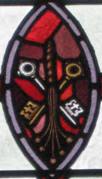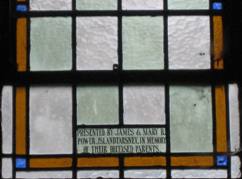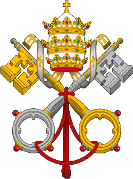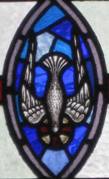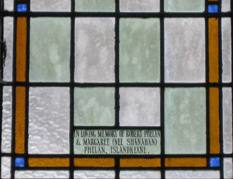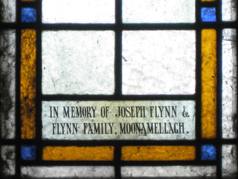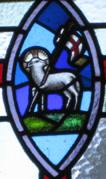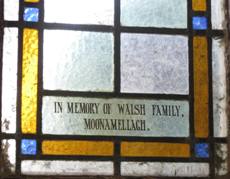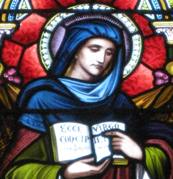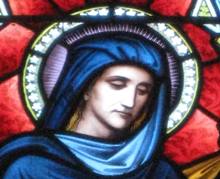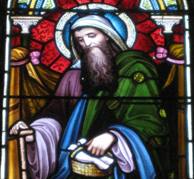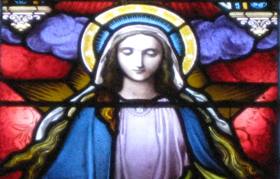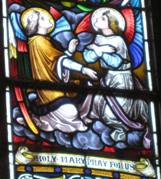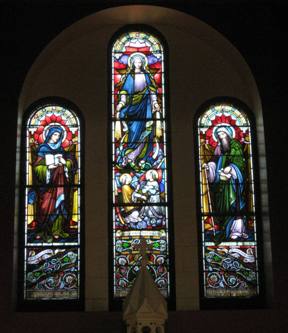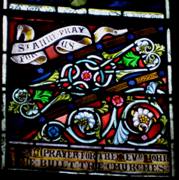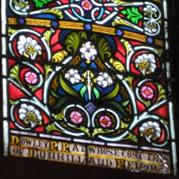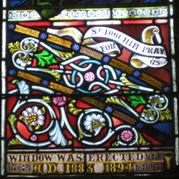Monthly Archives: January 2014
The fourth north transept window
The fourth north transept window
Here we see a flagellum and a pair of keys. The flagellum was a form of whip used for scourging. It was made of leather with leather thongs and had pieces of leather or metal knotted into the thongs so as to tear the flesh.
The Jewish practice was to deliver thirty-nine lashes but the Romans had no limit – the victim was scourged until almost dead –
“Five times I [St. Paul] received at the hands of the Jews the forty lashes less one”. [2 Cor 11:24].
There is one silver key and one gold key for which there are two interpretations. One interpretation is that the silver key symbolises the power to bind and loose on Earth, and the gold key the power to bind and loose in Heaven. The other interpretation is that the silver key represents “binding” and the golden key represents “loosing”.
The crossed keys are the “keys to the Kingdom of Heaven” and are the quintessential symbol of the Papacy as an institution. Indeed, the crossed keys are part of the papal insignia shown above –
“And I tell you, you are Peter, and on this rock I will build my church, and the gates of hell shall not prevail against it. I will give you the keys of the kingdom of heaven, and whatever you bind on earth shall be bound in heaven, and whatever you loose on earth shall be loosed in heaven.” [Matthew 16:18,19].
The third north transept window
The third north transept window
The main detail in this window is the stylised dove viewed from below.
The dove is not the dove of peace which usually carries an olive branch in its beak but, because of its halo, is taken to symbolise the Holy Spirit –
“In those days Jesus came from Nazareth of Galilee and was baptized by John in the Jordan. And when he came up out of the water, immediately he saw the heavens opening and the Spirit descending on him like a dove. And a voice came from heaven, ‘You are my beloved Son; with you I am well pleased.'” [Mark 1:9-11].
The third and fourth windows of the north transept are situated in the gable wall and are wider and of a different style to the others in the transept or to those in the nave. The same is true of the two gable windows in the south transept.
The second north transept window
The second north transept window
Here, the main detail shows a wooden cross, a hammer, a pair of pincers, and a crown of thorns.
These are all items associated with Jesus’ passion – the cross upon which Jesus was crucified, the hammer for hammering the nails into the cross through Jesus’ wrists and feet, and the pincers for pulling out the nails.
The first north transept window
The first north transept window
The main detail shows a lamb holding a staff surmounted by a banner. The banner itself bears a red cross on a white background like the St. George’s cross. In religious art such an image is known as an Agnus Dei (Lamb of God, in Latin).
In the Christian tradition, the ultimate mission of Jesus to die on the cross to atone for our sin is analogous to the sacrifice of a lamb. John the Baptist referred to Jesus as the Lamb of God –
“Behold the Lamb of God who takes away the sin of the world!”. [John, 1:29]
The North Transept Windows
The North Transept Windows
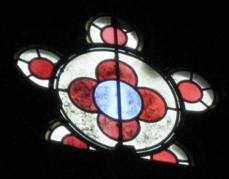
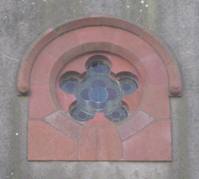
In the north transept there are seven windows one of which is the small window situated in the peak of the gable. Here, we show views from the inside and outside of the church.
This window cannot be photographed properly without the aid of a ladder or a giraffe as it is high up and partially hidden by its masonry surround. It has five outer circular panes, like the peak window in the south transept but unlike the peak windows in the east and west gables which have four and six outer panes, respectively.
We will discuss the other six windows in an east to west (right to left) direction, numbering them 1 to 6, respectively. They may be accessed using the menu at top left.
Saint Anne’s window
Saint Anne’s window
According to tradition and some apocryphal literature, Saint Anne (or Ann or Anna, from the Hebrew name Hannah, meaning favour or grace) was the mother of Mary and the grandmother of Jesus. Legends and stories abound concerning Anne and she is sometimes confused with Anna the Prophetess who was present at Jesus’ presentation in the Temple.
In the window, Anne is holding a book bearing the inscription “ECCE VIRGO CONCIPIET” (“Behold! The virgin will conceive”, in Latin). This is a reference to two passages in the Bible, one in the Old Testament and one in the New Testament –
“Therefore the Lord himself will give you a sign. Behold, the virgin shall conceive and bear a son, and shall call his name Immanuel”. [Isaiah 7:14].
“But as he considered these things, behold, an angel of the Lord appeared to him [Joseph] in a dream, saying, ‘Joseph, son of David, do not fear to take Mary as your wife, for that which is conceived in her is from the Holy Spirit. She will bear a son, and you shall call his name Jesus, for he will save his people from their sins.’ All this took place to fulfil what the Lord had spoken by the prophet: ‘Behold, the virgin shall conceive and bear a son, and they shall call his name Immanuel (which means, God with us)'”. [Matthew 1:20-23]
Matthew considers the Isaiah passage to be a prophesy of the virgin birth of Jesus, which is why the inscription in St. Anne’s book is so important.
Saint Joachim’s window
Our Lady’s window
Our Lady’s window
Our Lady is standing on a cloud above two angels who are kneeling on another cloud. She has her left foot on the head of a green snake or serpent. Our Lady is often seen crushing the head of the serpent in pictures and statues. It comes from a vision that St. Catherine Labouré received in 1830.
This is the serpent that tempted Eve in the Garden of Eden. It is often portrayed, as above, with a red apple in its mouth but, in fact, the type of fruit is not mentioned in the bible –
“Now the serpent was more crafty than any other beast of the field that the Lord God had made. He said to the woman, ‘Did God actually say, “You shall not eat of any tree in the garden”?'” [Genesis 3:1].
“So when the woman saw that the tree was good for food, and that it was a delight to the eyes, and that the tree was to be desired to make one wise, she took of its fruit and ate, and she also gave some to her husband who was with her, and he ate.” [Genesis 3:6].
In the Genesis story, the serpent represents evil or its personification, Satan. So the window shows Mary defeating evil.
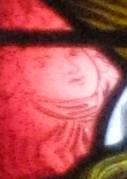
Did you notice the peculiar faces to the left and right of Mary’s head and shoulders? Click on the image to enlarge it and you will see the faces more clearly. Who do you think they are? Notice, too, the beautiful golden robe that one of the angels is wearing. The banner below the two angels says, “Holy Mary pray for us”.
The East Gable Windows
The East Gable Windows


There are four small windows in the peaks of the four gables. This one, in the east gable, is the smallest of the four. It is difficult to see from inside the church as it is partially obscured by the roof woodwork and by its surrounding masonry. Here we have shown an inside and an outside view.
These are the main windows in the church. The central window is partially hidden by the pinnacle of the main altar. Three figures are shown in the windows. They are, from left to right, Saint Anne, Our Lady, and Saint Joachim.
In the image on the left we ask, “St Anne Pray For Us” and, on the right, “St Joachim Pray For Us”.
The dedication at the bottom of the window is shown in the following three images.
HE BUILT THE CHURCHES |
OF DUNHILL AND FENOR |
A.D. 1883 1894 |




